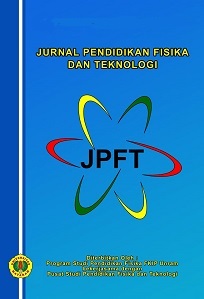The Effect of STEAM-Based Project-Based Learning Model on the Critical Thinking Skills of Eleventh-Grade Students in the Topics of Elasticity and Hooke's Law
DOI:
10.29303/jpft.v10i2.7960Published:
2024-12-04Issue:
Vol. 10 No. 2 (2024): July - DecemberKeywords:
project based learning, STEAM, Critical thinking skillsArticles
Downloads
How to Cite
Downloads
Metrics
Abstract
The critical thinking skills must be possessed by students in order to face various problems. To enhance students' critical thinking abilities, a teaching model that can support these skills is needed. This study aims to examine the effect of the Project-Based Learning (PBL) model based on STEAM on students' physics critical thinking skills. The material used in this study is elasticity. This study explores the impact of the Project-Based Learning model as an independent variable on critical thinking skills as a dependent variable. The research method used is a quasi-experimental design with a non-equivalent control group design. The population of this study consists of all 159 students of class XI MIPA at MAN 1 Lombok Tengah. The sample used in this study includes class XI MIPA 5 as the experimental class and class XI MIPA 6 as the control class, selected using purposive sampling technique. Data analysis in this study was conducted using normality tests, homogeneity tests, and hypothesis testing. Based on the data analysis, the final results show that the average critical thinking score for the experimental class was 82.71, categorized as high, and for the control class was 72.96, categorized as medium. The research hypothesis was analyzed using the t-test for pooled variances. The obtained t-value was 5.54, and the t-table value was 1.706 at a 5% significance level. Therefore, since the t-value > t-table, the null hypothesis (H0) is rejected and the alternative hypothesis (Ha) is accepted. Based on the analysis results, it can be concluded that there is an effect of the Project-Based Learning model on students' physics critical thinking skills.
References
Ansumarwaty, F., ‘Ardhuha, J., Hikmawati., Makhrus, M. (2023). Development of Student Worksheet for Sound Waves Based on Project Based Learning Model to Improve Students’ Science Literacy. Journal of Research in Science Education, 9(8).
Dewi, M. R. (2023). Kelebihan dan Kekurangan Project-based Learning Untuk Penguatan Profil Pelajar Pancasila Kurikulum Merdeka. Jurnal UPI, 19(2).
Diana, H, A., & Saputri. (2021). Model Project-Based Learning Terintegrasi STEAM Terhadap Kecerdasan Emosional dan Kemampuan Berpikir Kritis Siswa Berbasis Soal Numerasi. Jurnal Numeracy, 8(2).
Mu’minah, I. H. (2021). Studi Literatur: Pembelajaran Abad-21 Melalui Pendekatan STEAM (Science, Technology, Engineering, Arts and Mathematics) Dalam Menyongsong Era Society, 5(0).
Mu’minah, I., H., & Suryaningsih, Y.(2020). Implementasi STEAM (Science, Technology, Engineering, Arts and Mathematics) Pembelajaran Abad 21. 5(1).
Nurjanah, N., & Purwantoyo, E. (2023, November). Efektivitas Model Pembelajaran Project Based Learning Berbasis STEAM untuk Meningkatkan Kemampuan Berpikir Kritis dan Keterampilan Proses Pada Materi Perubahan Lingkungan. In Prosiding Seminar Nasional Biologi 11(0).
Putra, N, A,. Harjono, A,. Hikmawati. (2024). Keterampilan Berpikir Kritis Getaran Dan Gelombang Peserta Didik Kelas VIII Dengan Model Pembelajaran Berbasis Masalah. Jurnal Pendidikan, Sains, Geologi, dan Geofisika, 5(3).
Rasnawati, A., Rahmawati, W., Akbar, P., & Putra, H. (2019). Analisis Kemampuan Berpikir Kreatif Matematis Siswa SMK Pada Materi Sistem Persamaan Linear Dua Variabel (SPLDV) di Kota Cimahi. Jurnal Cendikia: Jurnal Pendidikan Matematika, 3(1)
Ridha, M. R., Zuhdi, M., & Ayub, S. (2022). Pengembangan perangkat pembelajaran PJBL berbasis STEM dalam meningkatkan kreativitas fisika peserta didik. Jurnal Ilmiah Profesi Pendidikan, 7(1).
Subiki., Putri, E., T., & Anggraeni, F., K., A. (2023). Pengaruh Model Pembelajaran Berbasis Proyek dengan Pendekatan STEAM terhadap Hasil Belajar Siswa SMA Mata Pelajaran Elastisitas Materi 9(0).
Sulastri., & Cahhyani, G, P., (2021). Pengaruh Project Based Learning dengan Pendekatan STEAM terhadap Kemampuan Berpikir Kritis pada Pembelajaran Online di SMK Negeri 12 Malang: Jurnal Pendidikan Akuntasi, 9(3).
Sumardiana, S., Hidayat, A., & Parno, P. (2022). Kemampuan Berpikir Kritis pada Model Project Based Learning disertai STEM Siswa SMA pada Suhu dan Kalor. Jurnal Pendidikan: Teori, Penelitian, dan Pengembangan, 4(7).
Wangi, U, A., Ayub, S., Harjono, A., Doyan, A. (2022). Pengembangan Perangkat Pembelajaran Fisika Berbasis Discovery Learning Untuk Meningkatkan Kemampuan Berpikri Kritis Peserta Didik. Jurnal Ilmiah Profesi Pendidikan 7(4).
Anggraini, N., Suana, W., & Sesunan, F. (2020). Pengaruh penerapan blendedlearning pada materi hukum newton tentang gerak terhadap motivasi belajar dan kemampuan pemecahan masalah. Tarbawi : Jurnal Ilmu Pendidikan, 16(1).
Author Biographies
Riadhatul Hasani, University of Mataram
Physics Education Study Program
Jannatin 'Ardhuha, University of Mataram
Physics Education Study Program
Ahmad Harjono, University of Mataram
Physics Education Study Program
Kosim Kosim, University of Mataram
Physics Education Study Program
License
Copyright (c) 2024 Riadhatul Hasani, Jannatin 'Ardhuha, Ahmad Harjono, Kosim Kosim

This work is licensed under a Creative Commons Attribution-ShareAlike 4.0 International License.
Authors who publish with Jurnal Pendidikan Fisika dan Teknologi (JPFT) agree to the following terms:
- Authors retain copyright and grant the journal right of first publication with the work simultaneously licensed under a Creative Commons Attribution License 4.0 International License (CC-BY-SA License). This license allows authors to use all articles, data sets, graphics, and appendices in data mining applications, search engines, web sites, blogs, and other platforms by providing an appropriate reference. The journal allows the author(s) to hold the copyright without restrictions and will retain publishing rights without restrictions.
- Authors are able to enter into separate, additional contractual arrangements for the non-exclusive distribution of the journal's published version of the work (e.g., post it to an institutional repository or publish it in a book), with an acknowledgement of its initial publication in Jurnal Pendidikan Fisika dan Teknologi (JPFT).
- Authors are permitted and encouraged to post their work online (e.g., in institutional repositories or on their website) prior to and during the submission process, as it can lead to productive exchanges, as well as earlier and greater citation of published work (See The Effect of Open Access).











